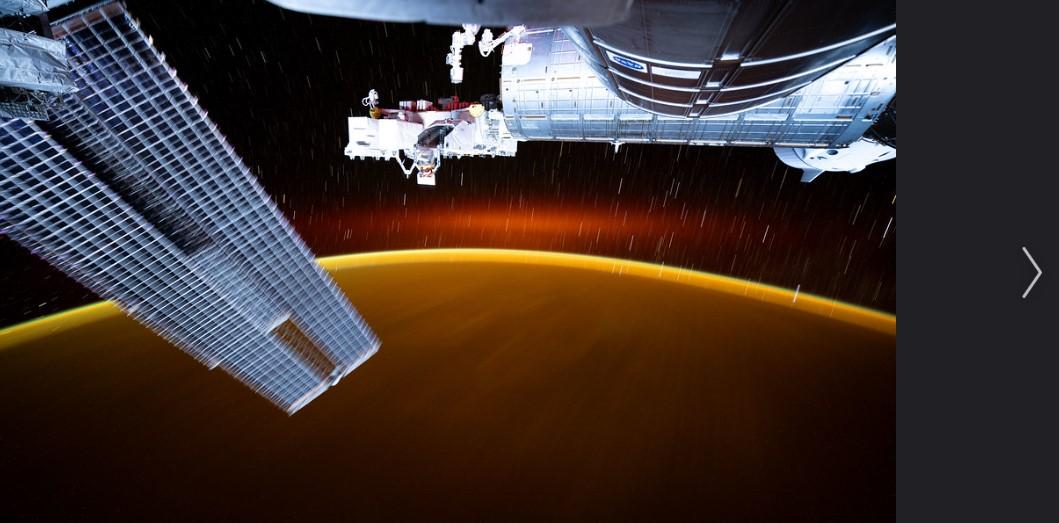
A long-duration photograph taken March 30 from the International Space Station highlights star trails and an atmospheric glow blanketing Earth's horizon. In the foreground is a set of the space station's main solar arrays (left), Japan's Kibo laboratory module (right) and the Kibo External Platform, which exposes experiments to the vacuum of space. The station was orbiting 259 mi. above the Pacific Ocean, southeast of Japan.
The U.S. plans to operate the International Space Station (ISS) for another five years, but risks to the orbital outpost are a growing concern, an independent NASA safety oversight panel says.
The ISS, which has hosted rotating teams of astronauts and cosmonauts since 2000, is experiencing a small but persistent air leak in the Russian segment, cause unknown. The air is leaking from cracks in the access tunnel, known as the PrK, between the Russian Zvezda service model and a docking port.
Launched in July 2000, Zvezda provides living volume, power distribution, flight control and propulsion assets. The leak was first noted nearly six years ago.
“The underlying cause of these cracks remains elusive. Leading theories include fatigue and environmentally assisted cracking,” Aerospace Safety Advisory Panel (ASAP) member Richard Williams, NASA’s former chief health and medical officer, said during the group’s April 17 meeting.
”The Russian and U.S. partners are working together testing and holding collaborative technical meetings. The primary mitigation activities at this point include application of patching materials to known cracks and limiting the PrK pressurization cycles to try to limit (structural) stress and fatigue,” he said. “The panel considers this one of our highest concerns.”
The ASAP also flagged potential issues with supply chains, budget uncertainty and disruptions to upcoming ISS cargo deliveries due to a ground transportation accident that prompted cancellation of a Northrop Grumman Cygnus resupply run in June.
The panel is also keeping close watch on a NASA-backed program to transition its microgravity research and tech demos from the ISS to a planned follow-on commercially owned and operated complex—with the U.S. government serving as the anchor tenant.
NASA is paying three teams—Axiom Space, Voyager’s Starlab Space, and a partnership of Blue Origin and Sierra Space—for initial design and development of so-called Commercial Low-Earth-Orbit Destinations (CLD).
The agency also has unfunded Space Act Agreements with Blue Origin, Northrop Grumman, Sierra Space, SpaceX, Special Aerospace Services, ThinkOrbital and Vast to advance commercial space-related efforts through NASA contributions of technical expertise, assessments, lessons learned, technologies, and data, the agency notes.
NASA intends to issue a draft CLD Phase 2 request for proposals (RFP) this summer. A Phase 2 CLD contract award or awards for additional commercial space station development is expected by summer 2026.
In an April 2 request for information (RFI), NASA said it is developing requirements for CLD Phase 2 capabilities that would support NASA and international astronauts, as well as other spaceflight participants safely in low Earth orbit, on a commercially owned and operated space station.
Participation in the CLD Phase 1 program is not a prerequisite to compete in Phase 2, the agency said.
A recent NASA-hosted aerospace industry technical exchange drew more than 140 attendees and representatives from more than 20 companies, a positive sign for economic interest in developing commercial space stations with NASA as one of many clients, ASAP member Mark Sirangelo noted.
NASA’s goal is to have one or more CLDs establish initial operating capability in Earth orbit by December 2029, with a continuous orbital crew presence established by December 2030 and a “full operational capability” by December 2031, he added.
NASA and its European, Japanese and Canadian space agency partners have committed to ISS operations through 2030. Russia’s budget allocations are on a different cycle so the country’s commitment to ISS operations beyond 2028 is pending.
Meanwhile, aboard the ISS NASA astronauts Anne McClain and Nichole Ayers are preparing for a May 1 spacewalk to relocate a communications antenna and install a mounting bracket ahead of the installation of an additional set of ISS Rollout Solar Arrays (IROSA).
The arrays will boost power generation capability by up to 30%, increasing the station’s total available power from 160 kW to up to 215 kW. The arrays will be installed on a future spacewalk following their arrival on a SpaceX Dragon commercial resupply services mission later this year.
The planned 6 1/2-hr. outing will be McClain’s third spacewalk and Ayers’s first. The spacewalk is the 275th in support of space station assembly, maintenance and upgrades.






